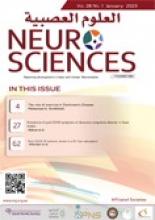To the Editor
We would like to discuss the recent publication by Aytac et al1 entitled ‘Association of intron 4 VNTR polymorphism in the NOS3 gene with rapid cycling and treatment resistance in bipolar disorder (BD): a case-control study.1 While BD patients with the b/b genotype and b allele had a decreased risk of rapid cycling and treatment resistance, those with the b/a genotype were more at risk for these issues, according to Aytac et al.1 Aytac et al1 also noted that the BD group with the b/b genotype experienced statistically fewer hospitalizations and higher Clinical Global Impression-Improvement Scale scores than the BD group with the b/a and a/a genotypes.1 The effect of the studied polymorphisms might be detected in the current report. However, it is important to discuss the confounding factors in the present study. At least, there are many genetic polymorphisms that might be related to BD. Examples are UGT1A4 and UGT2B7 Polymorphisms.2 Further studies to assess the effect of those possible confounding polymorphisms should be performed.
Reply from the Author
We received the correspondence to our original article “Association of intron 4 VNTR polymorphism in the NOS3 gene with rapid cycling and treatment resistance in bipolar disorder: a case-control study”. In this research, we reported that the bipolar disorder (BD) patients carrying the NOS3 intron 4 b/b genotype and b allele had a significantly lower frequency of rapid cycling and treatment resistance. Again, the number of hospitalizations and the CGI-I scores of the BD group with the b/b genotype were statistically lower than the BD group with b/a and a/a genotypes.1 As you mentioned, BD is a complex, multifactorial and polygenic disorder, and very little is known about its etiology. Experts in the field indicate that variations in many genes, each with a small effect, may combine to increase the risk of developing the condition.3,4 As we mentioned in the last paragraph of the introduction part of the article, the genome-wide scan of BD and investigation of population stratification effects on linkage provided evidence supporting susceptibility loci at 4q21, 7q36, 9p21, 12q24, 14q24, and 16p13.5 Since the NOS3 gene is also located in the 7q36, we investigated the association between clinical parameters of BD and the intron 4 VNTR variant in the NOS3 gene by comparing genotype distributions of patients with healthy controls. As it is known, the nitric oxide system is essential in oxidative stress, inflammation, neurotransmission, neuroplasticity, stress response, memory, and learning regulation.6,7 Therefore, in the discussion part, we discussed the relationship between the gene polymorphisms related to these systems mentioned above and BD.1 In the study you mentioned, Suzuki et al2 examined the relationship between UGT1A4 and UGT2B7 gene polymorphisms and blood drug levels in patients with treatment-resistant depressive disorder. They did not find the effect of these polymorphisms on the steady-state plasma concentrations of lamotrigine in these patients.2 Although the association between gene polymorphisms related to drug metabolism and treatment resistance in BD is crucial, it is not related to the subjects of our article. In addition, in the sample they studied, there was not only a BD patient group but also major depressive disorder, BD-II, and BD-I together.2 Therefore, we believe that our study is the first case-control study examining the association between intron 4 VNTR polymorphism in the NOS3 gene and BD according to treatment resistance, clinical characteristics, and scale scores in detail. If we consider the gene-gene, gene-environment interactions, and multi-genetic nature of BD in the etiology, more studies with further coding region variants in other populations are needed.
- Copyright: © Neurosciences
Neurosciences is an Open Access journal and articles published are distributed under the terms of the Creative Commons Attribution-NonCommercial License (CC BY-NC). Readers may copy, distribute, and display the work for non-commercial purposes with the proper citation of the original work.






